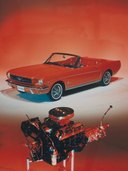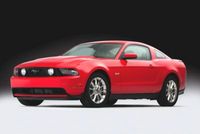Return of the Five Liter Ford Mustang
By Thom Cannell
Senior Editor
The Auto Channel
Detroit Bureau
 |
Viewing the new motor, laid out in social groupings like a valve
train—exhaust—block—pistons and squirters Smorgasbord was
to meet and chat with the actual developmental engineers; the team counts
less than ten. The new 5.0 creates 83 hp per liter, racing engine
territory.
 |
There are many keys to achieving the power and torque of the new engine. Having variable camshafts is one. Ford uses energy from the cams themselves to alter valve timing. Oil is the medium but their system will work reliably with hot and thin oil at low pressures and low idle speeds. Heads are new, compact and have a very direct intake and exhaust flow path. The block is robust and deeply sumped and baffled to permit sustained high-rpms and increase oil life to 10,000 mile. Internally, lightweight pistons have oil squirted directly up onto them for better lubrication and quicker cold start warmup.
The engine weighs 430 pounds making it a lightweight. Fuel economy is modestly improved for the 6-speed automatic and similar to 2009 models for manual transmission vehicles at 25 highway/17 city (up from 23 hwy/17 city) and 24 hwy/16 city. GT’s, like other Mustangs for 2011, use Electronic Power Assisted Steering (EPAS) for lower low-speed steering effort and improved on-center abilities, stiffer lower control arms at the rear plus a heftier rear stabilizer bar and retuned springs and dampers. Brembo brakes are available, as is a standard message center, blind spot mirrors, and Ford’s MyKey which can be programmed to keep kids, spouses, or you out of trouble by continuously sounding the fasten seat belt warning, limiting speed, and even limiting the stereo volume. Interior features like a 160 mph speedometer and 7,000 rpm redline tachometer are standard, as are 5.0 fender badges.
 |



